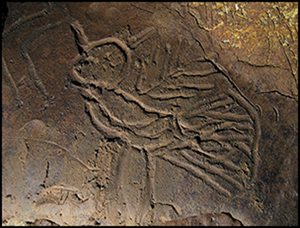Article contents
Discovering ancient cave art using 3D photogrammetry: pre-contact Native American mud glyphs from 19th Unnamed Cave, Alabama
Published online by Cambridge University Press: 04 May 2022
Abstract

Since 1979, when the first cave art was documented in North America, dozens of other examples have come to light. Among these, 19th Unnamed Cave in Alabama contains hundreds of pre-contact Native American mud glyph drawings. In 2017, 3D modelling of the glyphs was initiated, ultimately enabling digital manipulation of the chamber space and revealing images that could not be perceived prior to modelling. Most surprisingly, the cave's ceiling features very large anthropomorphic glyphs that are not apparent in situ due to the tight confines of the cave. We argue that photogrammetry offers untapped potential for not simply the documentation but also the discovery of a variety of archaeological phenomena.
- Type
- Research Article
- Information
- Copyright
- Copyright © The Author(s), 2022. Published by Cambridge University Press on behalf of Antiquity Publications Ltd.
References
- 5
- Cited by


